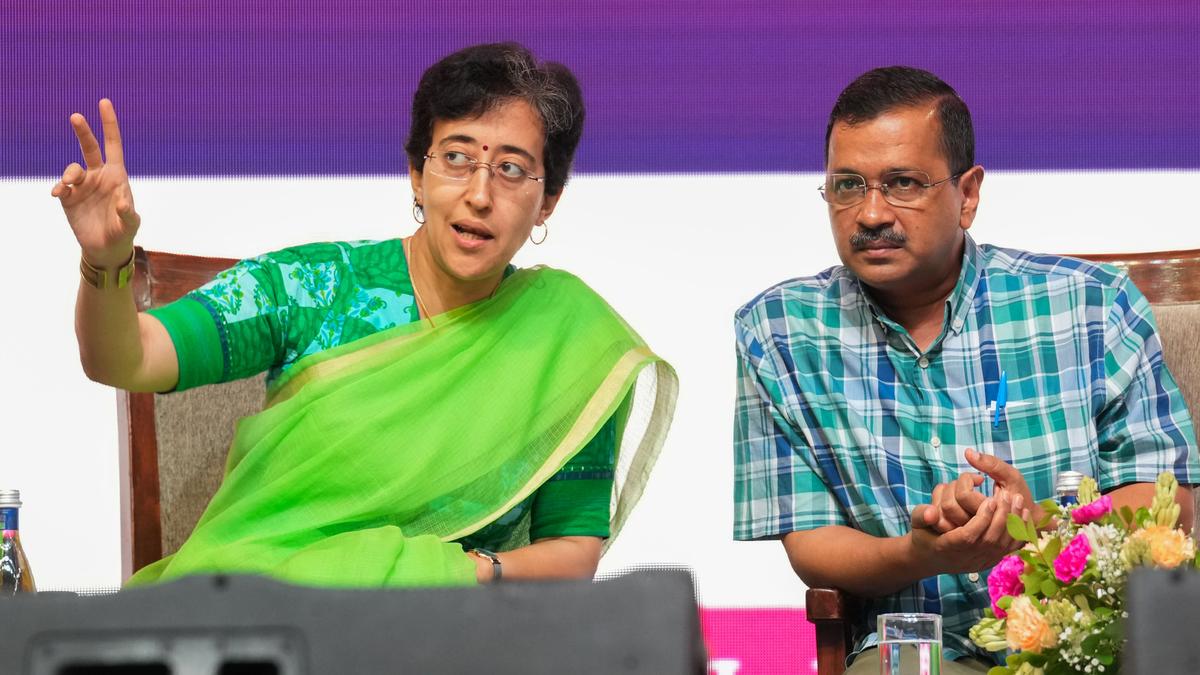Delhi Chief Minister Atishi with former Chief Minister Arvind Kejriwal. File
| Photo Credit: PTI
In 2015, before the Delhi Assembly elections, the Aam Aadmi Party (AAP) promised to revolutionise school education if it came to power. Since then, the AAP government has increased its allocation for education to nearly 25% of the Budget. It has sent teachers and principals for training programmes at the University of Cambridge, U.K.; the National Institute of Education, Singapore; and IIM Ahmedabad. It has decentralised funds for school management committees, vested more powers in the hands of community to spend; introduced the ‘happiness curriculum’; and proposed guidelines to prevent private schools from increasing their fees. On the face of it, these look like great reforms. However, the newly appointed Chief Minister, Atishi Marlena, who handles the Education portfolio, is staring at several challenges.
The first and most immediate challenge is to curb absenteeism and encourage children to attend school. In 2022-23, 17.85 lakh students were enrolled across the 1,070 government schools in Delhi. Of them, 6.67 lakh students (nearly 33%) were absent for seven consecutive days or 20 out of 30 working days between April 2023 to February 22, 2024. This is slightly higher than the national average of 28% (Annual Status of Education Report, 2019).
In a much-criticised move this June, the Delhi government asked all government schools to ensure that Class 9 students who have failed twice are counselled and requested to register with the National Institute of Open Schooling (NIOS). Just 6,200 of the 17,000 government school students who failed Class 9 for the second time in 2023-24 enrolled with NIOS; the rest slipped through the cracks.
The government’s rationale for its decision is to open new avenues for non-formal education for dropouts. However, as Delhi-based advocate, Ashok Agarwal, who has been fighting for fair implementation of the Right to Education, said, “It ensures that the Delhi government has a high pass rate to show as a measure of ‘success’.” The students of Delhi secured an overall pass percentage of 94.35% in 2023-24, which surpassed the national average of 93.60%. “We have agitated multiple times in front of the Chief Minister’s residence so that they withdraw this policy,” he added.
The government also decided to segregate children according to their learning abilities into two groups: Pratibha (loosely translated as intelligent) and Nishtha (steadfast). A parents’ forum moved the Delhi High Court against the government for this move. The government believes that dividing students according to their performance levels would allow it to identify those at risk of academic failure. But such divisions, as a senior NCERT official told The Hindu, is “discriminatory and can negatively impact the motivation of students.” It also raises questions about equality and dignity.
As far as infrastructure is concerned, government schools in the North East District, the poorest in terms of development indicators such as health and education, are a stark departure from the model schools that the government often portrays in advertisements. The problem of overcrowding is so acute that students are asked to attend school for only two hours on any given day or are called on alternative days so that multiple batches of students can be accommodated. The Delhi High Court has asked the government to address issues of lack of space and overcrowding, which were forcing students to spill into libraries, labs, staff rooms, and the principal’s office to attend classes.
The government’s decision to regulate fees of unaided private schools which were allotted land by government agencies also suffered a blow when the Delhi High Court stayed a government circular mandating certain schools to seek prior permission before raising fees. Mr. Agarwal said, “Unless Delhi brings in a law or regulation to check the unaided private school fee structure, little will change.”
For lasting changes in the school education system, the AAP will have to focus on bridging the gap between the brightest students and those who fail in Class 9; the latter cannot be ignored or left behind. It must focus on infrastructure issues and address the problem of overcrowding in schools in the North East District. Most importantly, it must pay attention to the poorest of the poor in Delhi and ensure that every child attends school.
Published – October 24, 2024 01:15 am IST

